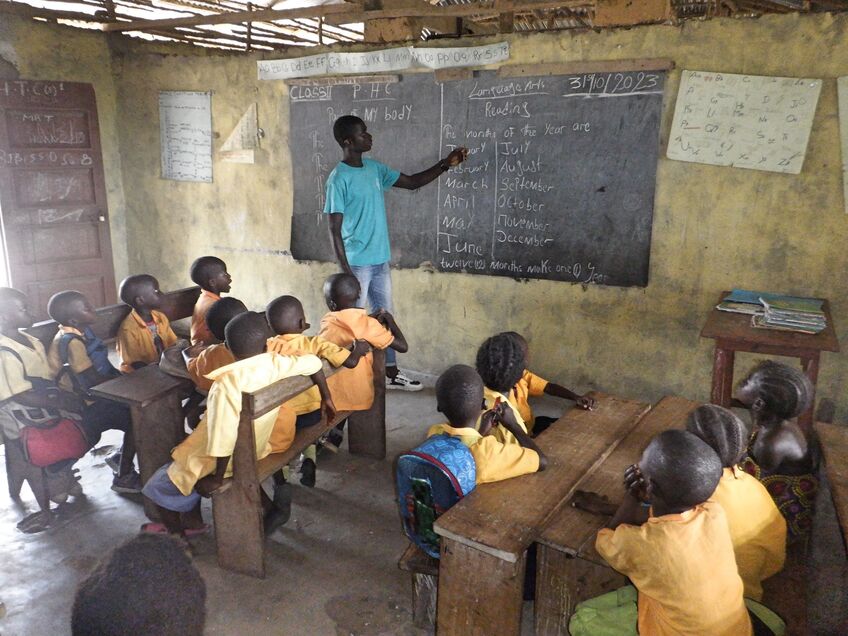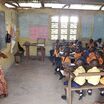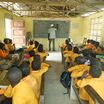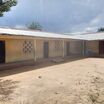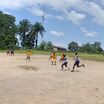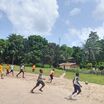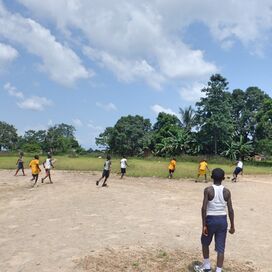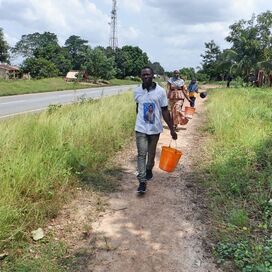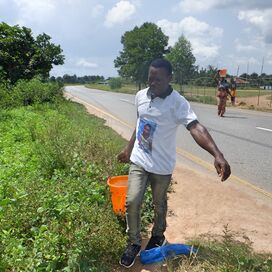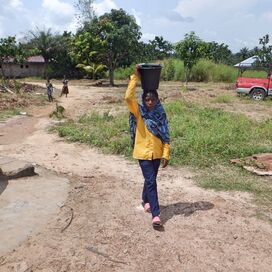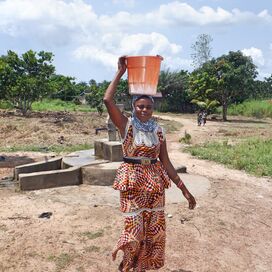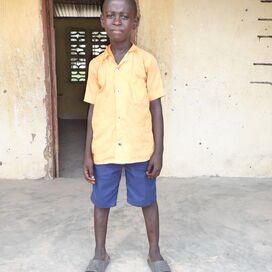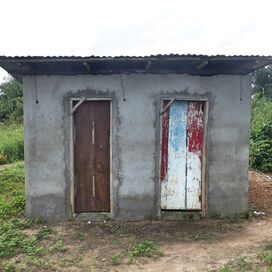Project
Kankaylay Primary School
Project Complete!
Kankaylay Primary School was established in 1987 with a temporary structure covered by a tarp and began with 47 students and 3 teachers. After the temporary structure fell down, the school was moved under a plum tree for 5 years. Seeing the importance of education, the surrounding community responded by constructing 3 classrooms. Five years later, a local organization added another 3 classrooms.
Today, the school has six classrooms and office space for the headteacher and four other teachers. The school has 364 students, 181 girls and 183 boys.
The 373 students and staff of Kankaylay Primary School struggle to access sufficient water. The community well they collect water from is not on the school property (they must walk off campus to gather water for the school and students), is often overcrowded or runs dry, and the road they must cross to get there is perilous.
Field Officer Alie Kamara said, "Most times, the water source is overcrowded by community women, and that delays school children from fetching water in the morning. Also, crossing Port Loko Road is a risk for school children to be hit by vehicles [or] motorbikes."
Teacher Isata Jolloh worries for her students daily.
"The problem of water has been affecting me, as a teacher and the school children. We only access water across the Port Loko Road. The school children must cross the road to fetch water, and this may expose them to being hurt by vehicle or motorbike," said 33-year-old Isata.
"Another challenge we face in our school is the school feeding program. Every day, our school children fetch water for the preparation of food. This will be delayed. Also, we need enough water to drink—the lack of enough water delays school children and staff not eating on time. We are unable to use the school toilet due to not enough water. For instance, if a staff wants to use the toilet, they always go to the nearby houses. This will cause us, the teachers, [to] not complete lessons," she continued.
Children are vocal regarding their experience in the water crisis as well.
Ibrahim, 10, said, "We have a latrine in our school, but there is no water well. So, I walk a long distance to access water across the road where vehicles pass every day. Sometimes, the water I have already fetched is not enough to serve our class. Even using the latrine is a problem because there is not enough water. When I want to use the latrine, I must get permission from my class teacher and then go to my house. This will cause me to miss out on lessons, and I will not be able to complete these lessons."
"The shortage of water from this water source has led the school not to practice better hygiene and sanitation. Because of the distance to fetch water, this causes pupils to miss their first period of teaching daily," continued Field Officer Alie Kamara.
Without access to safe, clean water, the students and staff cannot perform essential hygiene tasks, such as cleaning the latrines. This increases their risk of illness, which takes children out of the classroom even more and puts them further behind in their education.
Installing the well will enable teachers like Isata to no longer worry about their students' safety or when food can be prepared. Using the latrines on campus will allow children like Ibrahim to save time. This will eliminate the need for students to travel home during the school day, allowing them more time to focus on their studies and personal hygiene.
Field Officer Alie Kamara said, "Most times, the water source is overcrowded by community women, and that delays school children from fetching water in the morning. Also, crossing Port Loko Road is a risk for school children to be hit by vehicles [or] motorbikes."
Teacher Isata Jolloh worries for her students daily.
"The problem of water has been affecting me, as a teacher and the school children. We only access water across the Port Loko Road. The school children must cross the road to fetch water, and this may expose them to being hurt by vehicle or motorbike," said 33-year-old Isata.
"Another challenge we face in our school is the school feeding program. Every day, our school children fetch water for the preparation of food. This will be delayed. Also, we need enough water to drink—the lack of enough water delays school children and staff not eating on time. We are unable to use the school toilet due to not enough water. For instance, if a staff wants to use the toilet, they always go to the nearby houses. This will cause us, the teachers, [to] not complete lessons," she continued.
Children are vocal regarding their experience in the water crisis as well.
Ibrahim, 10, said, "We have a latrine in our school, but there is no water well. So, I walk a long distance to access water across the road where vehicles pass every day. Sometimes, the water I have already fetched is not enough to serve our class. Even using the latrine is a problem because there is not enough water. When I want to use the latrine, I must get permission from my class teacher and then go to my house. This will cause me to miss out on lessons, and I will not be able to complete these lessons."
"The shortage of water from this water source has led the school not to practice better hygiene and sanitation. Because of the distance to fetch water, this causes pupils to miss their first period of teaching daily," continued Field Officer Alie Kamara.
Without access to safe, clean water, the students and staff cannot perform essential hygiene tasks, such as cleaning the latrines. This increases their risk of illness, which takes children out of the classroom even more and puts them further behind in their education.
Installing the well will enable teachers like Isata to no longer worry about their students' safety or when food can be prepared. Using the latrines on campus will allow children like Ibrahim to save time. This will eliminate the need for students to travel home during the school day, allowing them more time to focus on their studies and personal hygiene.
Steps Toward a Solution
Our technical experts worked with the school to identify the most effective solution to their water crisis. They decided to drill a borehole well, construct a platform for the well, and attach a hand pump.
Abundant water often lies just beneath our feet. Aquifers—natural underground rivers—flow through layers of sediment and rock, offering a constant supply of safe water. A borehole well is drilled deep into the earth to access this naturally filtered and protected water. We penetrate meters, sometimes even hundreds of meters, of soil, silt, rock, and more to reach the water underground. Once found, we construct a platform for the well and attach a hand pump. The school gains a safe, enclosed water source capable of providing approximately five gallons of water per minute.
Training on Health, Hygiene & More
With the school's input, we've identified topics where training will increase positive health levels. We'll coordinate with them to find the best training date. Some examples of what we train on are:
- Improved hygiene, health, and sanitation habits
- Safe water handling, storage & treatment
- Disease prevention and proper handwashing
- Leadership, governance, & election of a water committee
- Operation and maintenance of the water point
8.4656765 latitude, -13.2317225 longitude
H2O for Life is not a WASH (water, sanitation and hygiene) project implementer. We have partnerships with non-governmental organizations (NGOs) implementing WASH in Schools projects around the world. Our NGO partners match funds needed for each school project. We also have a generous donor that provides us with an interest-free loan that, along with matching funds, allows for many projects to be started or possibly even completed before total funds have been raised. In rare situations we reserve the right to reallocate funds to alternate project(s).
Questions? Ask us at 651-756-7577 or info@h2oforlifeschools.org.
